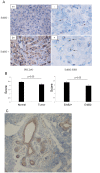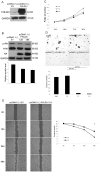Modulation of ErbB2 blockade in ErbB2-positive cancers: the role of ErbB2 Mutations and PHLDA1
- PMID: 25238247
- PMCID: PMC4169529
- DOI: 10.1371/journal.pone.0106349
Modulation of ErbB2 blockade in ErbB2-positive cancers: the role of ErbB2 Mutations and PHLDA1
Abstract
We set out to study the key effectors of resistance and sensitivity to ErbB2 tyrosine kinase inhibitors, such as lapatinib in ErbB2-positive breast and lung cancers. A cell-based in vitro site-directed mutagenesis lapatinib resistance model identified several mutations, including the gatekeeper ErbB2 mutation ErbB2-T798I, as mediating resistance. ErbB2-T798I engineered cell models indeed show resistance to lapatinib but remain sensitive to the irreversible EGFR/ErbB2 inhibitor, PD168393, suggestive of potential alternative treatment strategies to overcome resistance. Gene expression profiling studies identified a select group of downstream targets regulated by ErbB2 signaling and define PHLDA1 as an immediately downregulated gene upon oncogenic ErbB2 signaling inhibition. We find significant down-regulation of PHLDA1 in primary breast cancer and PHLDA1 is statistically significantly less expressed in ErbB2 negative compared with ErbB2 positive tumors consistent with its regulation by ErbB2. Lastly, PHLDA1 overexpression blocks AKT signaling, inhibits cell growth and enhances lapatinib sensitivity further supporting an important negative growth regulator function. Our findings suggest that PHLDA1 might have key inhibitory functions in ErbB2 driven lung and breast cancer cells and a better understanding of its functions might point at novel therapeutic options. In summary, our studies define novel ways of modulating sensitivity and resistance to ErbB2 inhibition in ErbB2-dependent cancers.
Conflict of interest statement
Figures







References
-
- Pauletti G, Godolphin W, Press MF, Slamon DJ (1996) Detection and quantitation of HER-2/neu gene amplification in human breast cancer archival material using fluorescence in situ hybridization. Oncogene 13: 63–72. - PubMed
-
- Slamon DJ, Clark GM, Wong SG, Levin WJ, Ullrich A, et al. (1987) Human breast cancer: correlation of relapse and survival with amplification of the HER-2/neu oncogene. Science 235: 177–182. - PubMed
-
- Slamon DJ, Godolphin W, Jones LA, Holt JA, Wong SG, et al. (1989) Studies of the HER-2/neu proto-oncogene in human breast and ovarian cancer. Science 244: 707–712. - PubMed
-
- Santin AD, Bellone S, Roman JJ, McKenney JK, Pecorelli S (2008) Trastuzumab treatment in patients with advanced or recurrent endometrial carcinoma overexpressing HER2/neu. Int J Gynaecol Obstet 102: 128–131. - PubMed
Publication types
MeSH terms
Substances
Grants and funding
LinkOut - more resources
Full Text Sources
Other Literature Sources
Medical
Research Materials
Miscellaneous

